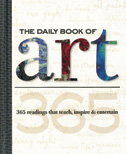Art Appreciation, Day by Day

 As I’ve mentioned before in this space, my education in landscape architecture pulled up lame when it came to instruction in art and art history. That shortfall has bothered me greatly as my career has progressed, but the silver lining is that I’ve been motivated to seek out sources I can use to teach myself what I think I need to know.
As I’ve mentioned before in this space, my education in landscape architecture pulled up lame when it came to instruction in art and art history. That shortfall has bothered me greatly as my career has progressed, but the silver lining is that I’ve been motivated to seek out sources I can use to teach myself what I think I need to know.
My latest find in this campaign is a wonderful book designed specifically to prompt personal voyages of exploration — The Daily Book of Art: 365 Readings That Teach, Inspire and Entertain by Colin Gilbert, Dylan Gilbert, Elizabeth T Gilbert, and Gabriel Guzman (Walter Foster Publishing, 2009). This volume delivers on its title’s promise by providing a year’s ration of 200-word descriptions of art and artists from a variety of thought-provoking perspectives.
The 376-page text was compiled by the various authors who organized it into ten rotating segments. The idea is simple: You pick up the book once a day, read an item (which takes practically no time at all) and then go on your way, contemplating what you’ve learned and maybe feeling inspired to continue with some research of your own. The approach is quite interactive and fun — and surprisingly gratifying when you consider that all you’re receiving are relatively small bits of information each day.
The rotation of segments is important, because each day you read something completely different from the day before. For example, the first segment covers basics of the art world, from how contracts work to basic terminology including contrast, color theory and form. It’s great information, but for most readers getting it in one big dose (as a long chapter, for instance) would make it tedious.
Now you can purchase this book— and other books reviewed by Mike Farley — through our online WaterShapes Store! Clickhere.
That’s not what happens with this book, because the item on, say, art contracts is followed by an item on the philosophy of art and how it teaches, expresses ideas and triggers emotions. The changes of pace take you in completely different directions and stop the potential for boredom in its tracks.
After bits on philosophy, you’ll see entries on art through the ages and how it changes with culture and history. Then come artist profiles, including a piece I read on Jackson Pollack. I’d heard of him, of course, but I’d never given much thought to his brand of modern painting or where he fit in the history of art. It piqued my interest enough that I googled him and spent some time getting more familiar with his work.
Another of the rotating sections covers art from around the world. This led to my discovery of The Bone Church in Prague — an architectural phenomenon made up entirely of human skeletons. Again, after reading the book’s brief treatment, I went to the computer and pulled up loads of information on this uniquely macabre work of art.
(Knowing my teenage son has a taste for the unusual, I subsequently shared what I’d uncovered with him. Then it hit me: Here I am having a wonderfully weird conversation about art and art history with my son, all because I read a 200-word primer on a church made out of bones!)
Other sections roll through artistic oddities; unexpected art forms; museums and galleries and other places in which art is displayed and collected; and a great one offering five-step sketching exercises that are both instructive and great fun if you have any interest at all in learning how to draw.
What I love about this book is how it takes a subject as huge as “art” and breaks it down into easily consumable pieces — all while prompting me to dig for more. If you’re looking for comprehensive discussions of art and its history, this is not the resource you want; but if you want an easy, enjoyable way to start exploring, this book might be just the ticket.
Mike Farley is a landscape designer with more than 20 years of experience and is currently a designer/project manager for Claffey Pools in Southlake, Texas. A graduate of Genesis 3’s Level I Design School, he holds a degree in landscape architecture from Texas Tech University and has worked as a watershaper in both California and Texas.









